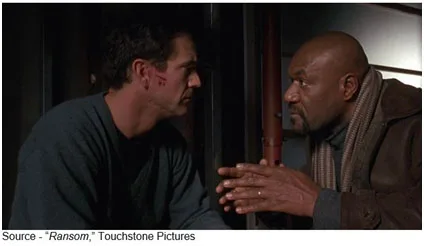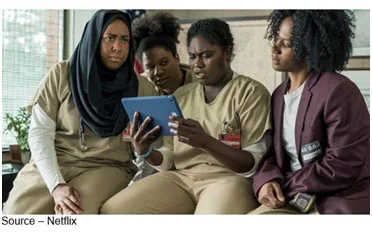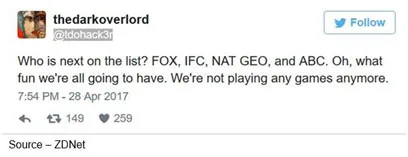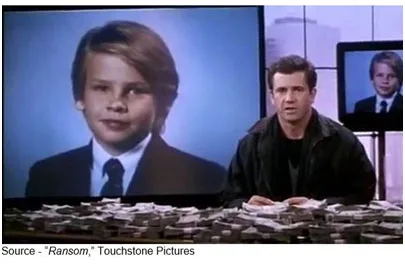Protecting Great Video Is Like Practicing Tough Love

At NAB (National Association of Broadcasters), one of the mixed emotion subjects that spread throughout the packed halls was that “brave, creative” TDO (TheDarkOverlord) had snagged most of fifth season’s segments of Netflix’s very popular show, Orange Is The New Black.
And if the company didn’t cough up a nice little ransom, he/they/it was going to release it on one of the many illegal file-sharing services for free!
Hastings and his crew ignored the “request” (actually, he probably said “***** you!”) and the deadline came and went.
The world kept turning and even my kid, who had been known to go to The Private Bay and other illegal file-sharing sites from time to time, didn’t bother watching it on his 13-inch notebook.

Outside of the approximately 100M people who subscribe to Netflix, we’re not certain who – if anyone – was just dying to binge on Orange Is the New Black; but maybe there were a few people who only get their entertainment from torrent sites.
Good for you.
But be honest. Do you go out and brag to real people and tell ‘em I binged on the stolen stuff and it was…awesome!?
Nope!
The “hey, let’s set entertainment free” philosophy has been around since the time you used to see red envelopes arrive in the mail so you could watch at home rather than go to the theatre; and probably even before that.
Back then, the entertainment industry came up with foolproof disc security called DRM (Digital Rights Management).
I always liked the name because it sounded like we actually had some rights to the content we purchased or rented.
But it was really just their systematic approach to copyright protection for their digital media.
The whole idea was to prevent unauthorized redistribution of digital media and restrict the ways folks could copy content they’ve purchased.
It didn’t work then and it certainly doesn’t work today now that download speeds are good/great.
In addition, there’s just flat too much really good free (ad supported) content available.
Every time you turn around, there’s another OTT (over the top) streaming service. And they’re so inexpensive (note: they can’t all survive), normal people don’t bother hunting for stuff in dark recesses for stolen stuff.
Instead, they simply tap-and-pay to watch the content they want instantly on their big screen. Or, if they’re like our kids, they watch the big screen, the medium screen and text about them on the small screen.
A lot of folks must agree with the approach because Wired recently reported that back in 2011, BitTorrent accounted for 23 percent of the daily Internet traffic; and now, it’s down to five percent.
YouTube and Facebook video (mostly free) sucks up most of the bandwidth while Netflix, Amazon, Hulu, Vimeo, TenCent, Alibaba and other SVOD and AVOD (subscription and advertising video on demand) services take up a huge chunk of capacity.

Yes, TDO did say he had more “really good” content from ABC, Fox National Geographic and AMC Network’s IFC and would be having “discussions” with them as well.
All I can say is “Dude get a job, get a life.”
First of all, content today is cheap…darn cheap.
Second, every time you do that you’re not punishing some monolithic company.
The M&E industry is really a huge number of independents — filmmakers, audio experts, editors, special effects, riggers, you name it and production/post people; and they work hard for their money.
If you really like their work, pay ‘em!
Yes, there are people in the world who like to practice kiasu, and I feel sorry for them.
The leak of Orange is the New Black won’t make or break Netflix.
It’s just an inconvenience people in the industry have to deal with and be more alert to the consequences of sloppy security.
Netflix and a lot of other firms are investing heavily in developing original content, licensing older hits and in fostering a roster of Indie filmmakers who will develop their own films, documentaries and episodic series to share in their income.
That’s the way the growing number of content providers and bundlers increase their subscriber numbers.
The more successful they are, the more interested black hats are in trying to make an easy buck by threatening services/studios to pay up to keep their content safe.
Trying to shake down Netflix wasn’t really as bad the Sony hackers in 2014 when they unleashed critical files like movies, episodes, scripts and email that embarrassed a lot of people and got more than a few fired.
That sucked!
Unfortunately, it’s painfully easy to hack into Hollywood, Bollywood and labels/studios around the world.
To create content for you to devour, services and studios rely on a wide range of specialists and third-party providers; and not everyone is as diligent about security as you are.

Or, they simply go phishing.
Color, audio, special effects people are always under time deadlines, so an email from the studio or client requesting the recipient simply run a check for them on his/her system may not seem unreasonable. BAM! they’re infected with a RAT (Remote Access Trojan).
Instantly, the user’s system belongs to the hacker.
Cyber threat mitigation has been a big concern for studios, service providers and even Indie filmmakers; and at NAB the sessions played to SRO (standing room only) crowds as people tried to find out how they could be proactive, rather than reactive, in protecting their work.
One of the ways is to use machine learning and AI (augmented intelligence) to predict and identify threats to keep hackers from entering the house.
Other approaches have included watermarking – an embedded signal in the audio, video or image that identifies the owner to track copying and monitor piracy – or issuing DMCA (Digital Millennium Copyright Act) to take down content from the web combined with a proactive cyber security education and enforcement program.
That includes:
- Staying vigilant – log files and changing management systems can give you early warning of a breach
- Ensuring everyone knows how to spot warning signs
- Keeping data on a need-to-know basis – only employees that need access to systems to do their jobs should have it
- Patching promptly when updates are issued – this can guard against many attacks
- Encrypting sensitive data – make it useless if it is stolen
- Using two-factor authentication – this can limit the damage that can be done with lost or stolen credentials
- Providing physical security – lock-up back-ups, archives and protection copies, since not all data theft happens online
OTT streaming video is only going to grow and become a vital opportunity for organizations and individuals to sell, rent, enjoy better and better content whether it’s through subscription or advertising supported services.
Protecting and monetizing the content is important for everyone in the industry
Content piracy can’t be totally eliminated because certain individuals will always feel everything on the Internet is free for them.
 And it’s your responsibility to discourage them, stopping short of Tom Mullen’s approach to his ransom situation, “I’m offering this money as a reward on your head. Dead or alive, it doesn’t matter. So, congratulations, you’ve just become a two-million-dollar lottery ticket… except the odds are much, much better.”
And it’s your responsibility to discourage them, stopping short of Tom Mullen’s approach to his ransom situation, “I’m offering this money as a reward on your head. Dead or alive, it doesn’t matter. So, congratulations, you’ve just become a two-million-dollar lottery ticket… except the odds are much, much better.”
# # #